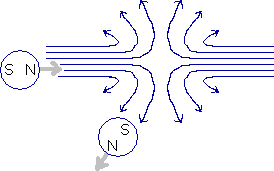1. IONS PUSHED TO ONE SIDE OF THE STALK
3. BOL'S IN VERTICAL MOTION - THE LORENTZ FORCE
4. BOL'S IN VERTICAL MOTION - PART 2
5. THE SUPERBOL AND ALTERNATING CURRENTS
13. MAGNETIC DUST SUCKED IN AND SPRAYED OUT
Regard one magnetic dust particle floating in the atmosphere. The south pole of the particle want to go south, the north pole of it wants to go north. These forces direct the particle along the magnetic field line and in fact tries to disrupt the particle (it doesn't succeed, field to weak). Both forces are equal so the particle will not be set in motion. See fig. 13.1. (mark the compass here)
![]()
![]() Fig. 13.1
Fig. 13.1
This is different in the magnetic field of the SuperBoL. We regard a magnetic dust particle in the horizontal plane between the two circlecurrents.

 Fig. 13.2
Fig. 13.2
The dust particle has directed itself to the magnetic field line it is on, see fig. 13.2. At the north pole of the magnetic dust particle the field line density is a little bit larger than at the south pole of the particle. So the magnetic field strength at the north pole of the dust particle is larger than at its south pole. The particle is a magnet in a magnetic field. The force now is simply along the magnetic field line and is proportional to the magnetic field line density. This is no Lorentz force; the force has no dependency on velocity no more.
As a consequence the dust particle is set in motion and moves into the SuperBoL along a magnetic field line. In the BoL the field lines curve sharply upward and downward and fan out in space completely, see fig. 13.3.

 Fig. 13.3
Fig. 13.3
When the dust particle follows the magnetic field line it keeps aligned with it. When the line curves the alignment of the particle follows the curve like a car follows the road. When approaching the BoL the field line density increases in the 2 dimensions of the horizontal plane (fig. 13.2). After following the curve - say upward - when leaving the BoL again the field line density decreases in the 3 dimensions of the upper half of the BoL.
Somewhere in between, inside the BoL, there must be a small area where the field doesn't increase no more and doesn't decrease yet and thus remains constant. If the particle decelerates and is at rest then it could remain there, as in fig. 13.1 - provided it isn't nudged out by other particles coming in. Well, let's suppose it is not decelerated and just follows its track.
Was the magnetic particle first attracted onto the inside at its north pole, now it is repulsed out at its south pole. The repulsion on the south pole is just a little bit stronger than the attraction on the north pole because the field has just a little bit more fanned out at the north pole's location. Thus S
wants to go out and N
wants to go in and this is unstable. Small deviations on its track will make it flip, the N
going towards the BoL and now being nearest to it, and S
going outside to its far side. And if not for the coherence of the particle both poles would just depart. Now the force on the north pole is a little bit stronger than on the south pole of the particle and the particle is dragged inside back again. There it eventually could stay in the force-free area, or if not then follow the line further back outside, back in the horizontal plane, and there it eventually flips again and the whole story starts all over.
I guess most particles just follow the line. They are dragged in, follow the curve and are sprinkled out in a cone downward and a cone upward with more force than they had been dragged in before. Well, that is, for the same reason the main stream could be the other way around: particles from the ground sucked in and then sprayed out again in the horizontal plane of the SuperBoL. Maybe that will happen more often! Since I guess the magnetic dust mainly lies on the ground; or IN the ground not too deep in the loose soil.
The Ordinary BoL is simpler. Dust is sucked in in a lower cone and sprinkled out in the cone above, see fig. 13.4. (Or the other way around, but is there much magnetic dust there in the air.)
![]()
 Fig. 13.4
Fig. 13.4
Here I want to insert an eyewitness report from the book of Andy Thomas, Vital Signs, page 28:
A small pictogram arose around Vivien and Gary Tomlinson in 1989, Surrey. Thrown by a strong force into standing crop from a nearby path, they described a tall glowing funnel reaching up to the sky and small mini-whirlwinds
dancing around their feet, spinning the stems down at an incredible speed.
The funnel, is that the magnetic dust? But the mini-whirlwinds, Ordinary BoL's?
Through the hart of every BoL runs an earthcurrent. The magnetic field of the earthcurrent will add an inward-outward directed Lorentz force to the vertical velocity component of the magnetic dust particle. And it will add an upward-downward directed Lorentz force to the horizontal radial velocity component. And it is a pulsed earthcurrent, which cause the magnetic field to get stronger and weaker along with the pulses. The trace of one magnetic dust particle might remain in one and the same vertical plane, but it is complicated.